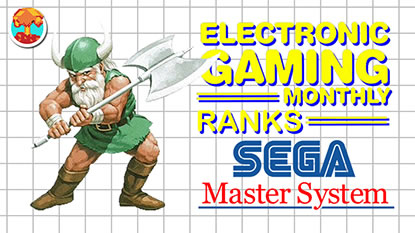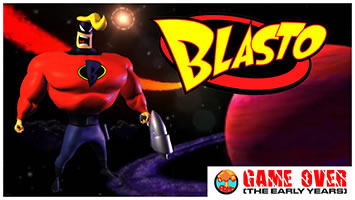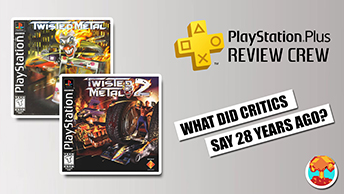- CLASSIC MAGAZINES
- REVIEW CREW
A show recapping what critics thought back
when classic games first came out! - NEXT GENERATION'S BEST & WORST
From the worst 1-star reviews to the best
5-stars can offer, this is Next Generation! - NINTENDO POWER (ARCHIVE)
Experience a variety of shows looking at the
often baffling history of Nintendo Power! - MAGAZINE RETROSPECTIVE
We're looking at the absolutely true history of
some of the most iconic game magazines ever! - SUPER PLAY'S TOP 600
The longest and most ambitious Super NES
countdown on the internet! - THEY SAID WHAT?
Debunking predictions and gossip found
in classic video game magazines! - NEXT GENERATION UNCOVERED
Cyril is back in this spin-off series, featuring the
cover critic review the art of Next Generation! - HARDCORE GAMER MAGAZING (PDF ISSUES)
Download all 36 issues of Hardcore Gamer
Magazine and relive the fun in PDF form!
- REVIEW CREW
- ELECTRONIC GAMING MONTHLY
- ELECTRONIC GAMING MONTHLY RANKS
From Mario to Sonic to Street Fighter, EGM
ranks classic game franchises and consoles! - ELECTRONIC GAMING MONTHLY BEST & WORST
Counting down EGM’s best and worst reviews
going year by year, from 1989 – 2009! - ELECTRONIC GAMING BEST & WORST AWARDS
11-part video series chronicling the ups and
downs of EGM’s Best & Worst Awards!
- ELECTRONIC GAMING MONTHLY RANKS
- GAME HISTORY
- GAME OVER: STORY BREAKDOWNS
Long-running series breaking down game
stories and analyzing their endings! - A BRIEF HISTORY OF GAMING w/ [NAME HERE]
Real history presented in a fun and pithy
format from a variety of game historians! - THE BLACK SHEEP
A series looking back at the black sheep
entries in popular game franchises! - INSTANT EXPERT
Everything you could possibly want to know
about a wide variety of gaming topics! - FREEZE FRAME
When something familiar happens in the games
industry, we're there to take a picture! - I'VE GOT YOUR NUMBER
Learn real video game history through a series
of number-themed episodes, starting at zero! - GREAT MOMENTS IN BAD ACTING
A joyous celebration of some of gaming's
absolute worst voice acting!
- GAME OVER: STORY BREAKDOWNS
- POPULAR SHOWS
- DG NEWS w/ LORNE RISELEY
Newsman Lorne Riseley hosts a regular
series looking at the hottest gaming news! - REVIEW REWIND
Cyril replays a game he reviewed 10+ years
ago to see if he got it right or wrong! - ON-RUNNING FEUDS
Defunct Games' longest-running show, with
editorials, observations and other fun oddities! - DEFUNCT GAMES QUIZ (ARCHIVE)
From online quizzes to game shows, we're
putting your video game knowledge to the test!- QUIZ: ONLINE PASS
Take a weekly quiz to see how well you know
the news and current gaming events! - QUIZ: KNOW THE GAME
One-on-one quiz show where contestants
find out if they actually know classic games! - QUIZ: THE LEADERBOARD
Can you guess the game based on the classic
review? Find out with The Leaderboard!
- QUIZ: ONLINE PASS
- DEFUNCT GAMES VS.
Cyril and the Defunct Games staff isn't afraid
to choose their favorite games and more! - CYRIL READS WORLDS OF POWER
Defunct Games recreates classic game
novelizations through the audio book format!
- DG NEWS w/ LORNE RISELEY
- COMEDY
- GAME EXPECTANCY
How long will your favorite hero live? We crunch
the numbers in this series about dying! - VIDEO GAME ADVICE
Famous game characters answer real personal
advice questions with a humorous slant! - FAKE GAMES: GUERILLA SCRAPBOOK
A long-running series about fake games and
the people who love them (covers included)! - WORST GAME EVER
A contest that attempts to create the worst
video game ever made, complete with covers! - LEVEL 1 STORIES
Literature based on the first stages of some
of your favorite classic video games! - THE COVER CRITIC
One of Defunct Games' earliest shows, Cover
Critic digs up some of the worst box art ever! - COMMERCIAL BREAK
Take a trip through some of the best and
worst video game advertisements of all time! - COMIC BOOK MODS
You've never seen comics like this before.
A curious mix of rewritten video game comics!
- GAME EXPECTANCY
- SERIES ARCHIVE
- NINTENDO SWITCH ONLINE ARCHIVE
A regularly-updated list of every Nintendo
Switch Online release, plus links to review! - PLAYSTATION PLUS CLASSIC ARCHIVE
A comprehensive list of every PlayStation
Plus classic release, including links! - RETRO-BIT PUBLISHING ARCHIVE
A regularly-updated list of every Retro-Bit
game released! - REVIEW MARATHONS w/ ADAM WALLACE
Join critic Adam Wallace as he takes us on a
classic review marathon with different themes!- DEFUNCT GAMES GOLF CLUB
Adam Wallace takes to the links to slice his way
through 72 classic golf game reviews! - 007 IN PIXELS
Adam Wallace takes on the world's greatest spy
as he reviews 15 weeks of James Bond games! - A SALUTE TO VAMPIRES
Adam Wallace is sinking his teeth into a series
covering Castlevania, BloodRayne and more! - CAPCOM'S CURSE
Adam Wallace is celebrating 13 days of Halloween
with a line-up of Capcom's scariest games! - THE FALL OF SUPERMAN
Adam Wallace is a man of steel for playing
some of the absolute worst Superman games! - THE 31 GAMES OF HALLOWEEN
Adam Wallace spends every day of October afraid
as he reviews some of the scariest games ever! - 12 WEEKS OF STAR TREK
Adam Wallace boldly goes where no critic has
gone before in this Star Trek marathon!
- DEFUNCT GAMES GOLF CLUB
- DAYS OF CHRISTMAS (ARCHIVE)
Annual holiday series with themed-episodes
that date all the way back to 2001!- 2015: 30 Ridiculous Retro Rumors
- 2014: 29 Magazines of Christmas
- 2013: 29 Questionable Power-Ups of Christmas
- 2012: 34 Theme Songs of Christmas
- 2011: 32 Game Endings of Christmas
- 2010: 31 Bonus Levels of Christmas
- 2009: 30 Genres of Christmas
- 2008: 29 Controls of Christmas
- 2007: 34 Cliches of Christmas
- 2006: 33 Consoles of Christmas
- 2005: 32 Articles of Christmas
- 2004: 31 Websites of Christmas
- 2003: 29 Issues of Christmas
- 2002: 28 Years of Christmas
- 2001: 33 Days of Christmas
- NINTENDO SWITCH ONLINE ARCHIVE
- REVIEW ARCHIVE
- FULL ARCHIVE
Only One Time Around for You
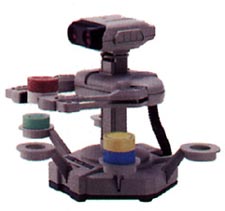
After many years of trying and two games under his belt, Nintendo's Robot Operated Buddy just couldn't seem to phone home.
It would be easy to point out a lot of games that never had sequels for one reason or another, but that's no fun, and frankly, it would take up many more pages. Instead we wanted to look at some concepts and ideas companies will never try again. Products like Gyromite for the original Nintendo Entertainment System.
The novelty behind Gyromite was that it used Nintendo's clunky robot named R.O.B. The Robot Operated Buddy, and Nintendo dubbed it, was a stand alone control that lifted and dropped blocks to affect the game play. Considering there had just been a video game crash, Nintendo figured that it might take some flashy "toys" to get the public interested in gaming.
But while the effort was well intentioned, and probably ended up working to reenergizing the industry in a small way, R.O.B. just didn't work. The accessory would have a hard time keeping up with Gyromite, and would become a frustrating experience to even the most loyal Nintendo fans. It was also something of an eye sore, just sitting there next to you imitating E.T.
Of course, Gyromite wasn't the only game that used this funky little robot. Stack-Up also attempted to get
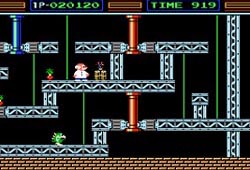
Perhaps the most depressing thing of all was that even if R.O.B. had worked, Gyromite still wouldn't have been any fun!
This fiasco ultimately taught Nintendo a valuable lesson they have stuck to ever sense: accessories need to do more than just sit there. Be it the power pad or light gun, Nintendo kept the control interactive with the player from that point on.
For a company so concerned with perfection, Nintendo has a way of making some questionable decisions when launching a new console. Take their most recent system, the GameCube, for example. Unlike every other console launched by the Washington-based company, the GameCube didn't have a Mario game anywhere in sight.
Now that may not seem like much, but just look at the track record. The Super NES had Super Mario World, GameBoy had Super Mario Land, Nintendo 64 had Super Mario 64, heck, even the Virtual Boy launched with Mario Tennis!! But not the GameCube. Oh no, it had a game called Luigi's Mansion.
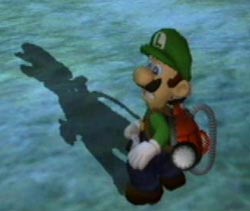
A timid Luigi spots a gang of wild pokemon at 9 o'clock, he fears his arsenal is useless!
But after poor sales, negative reviews, and not a whole lot of interest in a follow up, Nintendo may have finally learned a valuable lesson. You see, Nintendo needs to stick with Mario titles, especially when they launch. It's familiar, it's something everybody likes, and most importantly, it's what's going to sell your system. You don't need to look much further than the GameBoy Advance, which launched with a number of Mario related titles, and has flourished ever since.
Sega found themselves in a similar situation a few years before Luigi ever stepped foot into that haunted mansion. Knuckles Chaotix was supposed to be the great Sonic the Hedgehog spin off, sort of what the Jefferson's was to All in the Family. Problem was, with unconventional game play, silly characters, and horrible level design; it was more along the lines of that Gloria show.
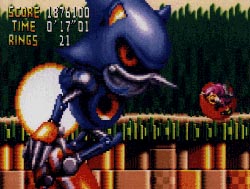
The bigger they get, the lamer everything seems!
Not all games on this list should be considered bad; in fact, some of them are unique in a rather pleasant way. Final Lap Twin, for the TurboGrafx-16, was a pretty solid racing game for that era, a genuine cut above your average racer. It featured a two player mode, fast visuals, good handling, and enough tracks you keep you interested for a good long time.
What sets Final Lap Twin apart, however, is it's rather unconventional use of role playing game elements. In the quest mode, your character travels the countryside looking for both random battles and story driven side quests. The winner of each fight is determined by who wins the race, and you win money and experience to upgrade your character and vehicle.
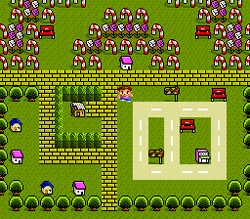
A car racing role playing game, eh? That's pretty hard to believe. Next you'll be telling me it takes place in Candyland!!
When Electronic Arts first announced Shaq Fu: Enforcer of Justice, we were all pretty dumbfounded. Developed by the competent hands at Delphine Software, the same people that brought us the stunning Flashback: Quest for Identity, all we can figure is Shaq Fu must have looked pretty good on paper.
If there's one thing that Shaq is good at it's playing basketball, I don't think anybody would argue with that. But outside the court he's nothing short of a disaster. When it comes to acting, it takes a certain kind
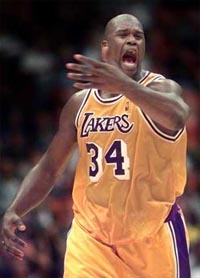
"HEY!! I'm Shaq, dammit. Just because I'm big and stupid doesn't mean you can make fun of my hip hop!"
So perhaps Shaq had it coming, and some company was just too stupid not to see the signs. Whatever your conspiracy theory, there's one thing that nobody will dispute; Shaq Fu is among the worst fighting games of all time. The controls aren't responsive, the graphics are small, the characters (especially Shaq) are stupid, and there just aren't any reasons to get excited about the package.
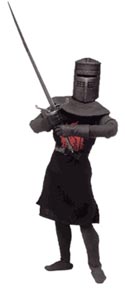
There really is no reason to run this picture, except it brings a smile to my face. And really, that's a good enough reason for me!
So if having a top celebrity doesn't help your fighting game and a sidekick hasn't lived up to his potential, then how else are you supposed to make money? Blood and violence? Massive amounts of limbs being chopped off, heads being decapitated, and various other stomach churning moves?
Contrary to popular belief, violence is not always a draw. While parent groups and the government came down on the likes of Mortal Kombat, they conveniently forgot to notice how UNPOPULAR other ultra-violent video games were. Actually, it wasn't games, but just game, singular. You see, even in the hay day of blood soaked fighting games, one title flopped even with excessive violence. That game was Time Killers.
With characters armed with swords, chainsaws, and other sharp objects, players were rewarded for being the first to sever key body parts from their opponents. It would be good to aim for the arm, for example, because your opponent would no longer be able to swing his blade. Aim for the legs and you can watch him bounce around trying to get close enough to end the battle. Keep cutting and you'll have the Dark Knight from Monty Python and the Holy Grail. But I digress.
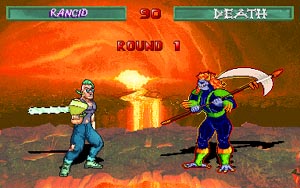
Having just returned from the Van Halen concert, Death is ready to take on any new punk!
No matter the reason, it certainly flies in the face of everybody who use blanket claims like violence sells. There have been many other games that half flopped, but none of them as violent. Time Killers set out to redefine violence in the arcades, but it ended up being nothing more than a final stop on a list filled with products that ended up influencing nothing.
HOME |
CONTACT |
NOW HIRING |
WHAT IS DEFUNCT GAMES? |
NINTENDO SWITCH ONLINE |
RETRO-BIT PUBLISHING
Retro-Bit |
Switch Planet |
The Halcyon Show |
Same Name, Different Game |
Dragnix |
Press the Buttons
Game Zone Online | Hardcore Gamer | The Dreamcast Junkyard | Video Game Blogger
Dr Strife | Games For Lunch | Mondo Cool Cast | Boxed Pixels | Sega CD Universe | Gaming Trend
Game Zone Online | Hardcore Gamer | The Dreamcast Junkyard | Video Game Blogger
Dr Strife | Games For Lunch | Mondo Cool Cast | Boxed Pixels | Sega CD Universe | Gaming Trend
Copyright © 2001-2025 Defunct Games
All rights reserved. All trademarks are properties of their respective owners.
All rights reserved. All trademarks are properties of their respective owners.













